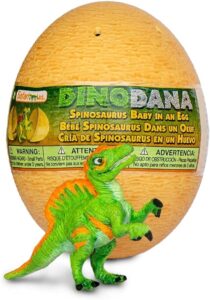How are Dinosaur Eggs Fossilized: Unveiling Prehistoric Secrets
Dinosaur eggs are fossilized through a process called permineralization. This occurs when minerals carried by water infiltrate eggshells and replace the organic material.
Discovering fossilized dinosaur eggs provides scientists with invaluable insights into the lives of these ancient reptiles. Over time, as dinosaur eggs were buried under layers of sediment, they experienced mineral-rich groundwater seeping into their microscopic pores. The gradual replacement of organic materials with minerals turned these eggs into stone, preserving their shape and size.
Through this natural marvel, permineralization, we gain a fascinating window into the past, studying not just the eggs, but also potential embryonic remains within. Each fossilized egg is a crucial clue, aiding paleontologists in understanding dinosaur reproduction and development. By focusing on these remnants of prehistoric life, we continue to unravel the mysteries that have been locked within the earth for millions of years.

Credit: www.linkedin.com

The Prehistoric Puzzle Of Dinosaur Eggs
Imagine walking through a remote, windswept desert. Suddenly, a small, stone-like shape catches your eye. You’ve stumbled upon a dinosaur egg, a fossilized remnant from a time when giants roamed the Earth. These eggs are prehistoric treasures that hold secrets from over 65 million years ago.
Fossilized Eggs: Windows Into The Distant Past
Dinosaur eggs serve as time capsules, revealing details about ancient life. Scientists study these eggs to understand dinosaur behavior and environment. Fossilization requires specific conditions: rapid burial, mineral-rich waters, and millions of years. Let’s explore this process.
- Eggs are laid in sediment like sand or mud.
- The sediment quickly covers the eggs, protecting them from scavengers.
- Minerals in groundwater slowly replace the original shell and contents.
- Over millions of years, the eggs harden into rock, preserving their shape.
Perfect conditions make fossilization rare but when it happens, it’s like a snapshot of prehistoric life.
The Rarity Of Dinosaur Egg Discoveries
Finding dinosaur eggs is rare. Unlike bones, eggs are fragile and less likely to survive the test of time. Discoveries are often accidental, happening during construction or exploration in sedimentary rock areas. Let’s see the factors making these finds so special:
| Factor | Reason for Rarity |
|---|---|
| Material | Eggshells are more delicate than bones. |
| Exposure | Eggs are often destroyed by natural processes before fossilizing. |
| Location | Eggs need specific conditions to fossilize. |
Each egg discovery advances our knowledge of the past.
Conditions Favoring Fossilization
Not every dinosaur egg turns into a fossil. The eggs that do become fossils were lucky. They were in the right place at the right time. For a dinosaur egg to become a fossil, certain conditions must be just right. Below, we’ll explore what it takes for these ancient treasures to be preserved for millions of years.
From Nest To Stone: The Process Of Permineralization
When dinosaur eggs are buried quickly, they can become fossils. This is called permineralization. Think of it like a special hardening process. Minerals in water seep into the pores of the eggshell. Over time, these minerals turn the egg into stone.
- Quick burial is key to stop the eggs from decaying.
- Minerals like silica must be in the groundwater.
- The eggs need to be undisturbed for a very long time.
The Role Of Sediments In Preserving Ancient Ovum
Sediments are like a blanket over the dinosaur eggs. They help keep the eggs safe. Fine-grained sediments, like mud, work best. They pack around the eggs and protect them from damage.
| Type of Sediment | Role in Fossilization |
|---|---|
| Mud | Covers eggs quickly and keeps oxygen away. |
| Sand | Can protect, but not as well as mud. |
| Clay | Binds tightly around the eggs, preserving their shape. |
Eggs must be protected from scavengers, weather, and time. Sediments do this job well. Here is why:
- Sediments prevent air and bacteria from reaching the eggs.
- They guard the eggs against the weight of the earth above.
- They shield the eggs from moving water which could wash them away.
Exploring Different Types Of Dinosaur Egg Fossils
The remnant whispers of ancient giants echo through the discovery of dinosaur egg fossils. These prehistoric treasures offer a unique window into the lives of dinosaurs. But not all dinosaur egg fossils are the same. They differ in texture, composition, and even how dinosaurs arranged them in their nests.
Within these fossils, each texture and composition tells a story. These details hint at different dinosaur species, their nesting behavior, and environmental adaptations. Let’s unearth the secrets wrapped within the shell of these ancient eggs.
Varieties Of Shell Texture And Composition
Shell textures and compositions provide vital clues about the dinosaurs that laid them.
- Prismatic structure – Indicates strong, water-resistant shells.
- Granular texture – Possible sign of land-living dinosaurs.
- Porous shells – Could suggest a wetland dweller.
Mineral replacement during fossilization preserves these details. Calcium carbonate in the eggs transforms over time. The result? A unique mineral composition that withstands the test of time.
Clutch Configurations And Their Significance
The arrangement of dinosaur eggs in a nest—or clutch configuration—reveals social and incubation behaviors.
| Configuration Type | Significance |
|---|---|
| Linear | May indicate limited space or nest-building strategy. |
| Radial | Suggests active brooding by the parent dinosaur. |
| Scattered | Could imply external disturbances or rushed laying. |
Dinosaur eggs sometimes found in concentric circles have fascinated scientists. This pattern might suggest communal nesting or a protective strategy against predators.
Mother dinosaurs may have organized their nests meticulously. Such insights shed light on parenting styles and survival instincts.
Exploring the different types of dinosaur egg fossils brings moments from prehistory into our present understanding. Each shell preserves a piece of the life of creatures that once roamed the earth.

Credit: www.sciencefocus.com
Technologies Unraveling Fossil Secrets
Imagine holding a piece of prehistory in your hands: a dinosaur egg. Not the egg itself, but its stone echo, fossilized over millions of years. New technologies now allow scientists to unlock the mysteries of these ancient pods. These cutting-edge tools reveal the hidden stories within the stony shells, helping us understand the lives of creatures lost to time.
Imaging Techniques And Egg Structure Analysis
State-of-the-art imaging techniques are revolutionizing paleontology. No longer reliant on chisels and brushes alone, scientists use non-invasive tools to peer inside fossils. One such method, computed tomography (CT) scanning, allows researchers to create 3D models of dinosaur eggs. These models show intricate details without damaging the fossils.
- High-resolution images reveal the texture and density of eggshells.
- Layers and structures, once hidden, now offer clues to egg formation and embryonic growth.
Digital reconstruction provides a view of prehistoric life at its beginning stages.
Chemical Mapping To Understand Egg Preservation
Chemical mapping dives deeper into the egg’s composition. Techniques like X-ray fluorescence (XRF) pinpoint elements within the fossil. This sheds light on the conditions under which the eggs were fossilized.
| Element | Clue |
|---|---|
| Calcium | Original shell material |
| Iron | Later mineralization |
Subtle chemical changes suggest different environmental factors that affected fossilization. Such analyses help scientists understand not just the eggs, but the ecosystem that supported dinosaur life.
Insights Gained From Studying Fossilized Dinosaur Eggs
Dinosaur eggs that have turned to stone tell us secrets from ancient worlds. These fossils teach us how dinosaurs hatched, lived, and even who they might be related to. Let’s explore what scientists have learned by studying these remarkable fossils.
Reconstructing Dinosaur Reproductive Behavior
Discovering nests, eggshells, and embryos gives clues about dinosaur family life. Researchers have mapped out nesting sites to see how dinosaurs took care of their eggs. They find patterns in how the eggs are laid out. This shows if dinosaurs were lone nesters or if they had big nesting colonies. Some even built nests, a hint they protected their eggs from danger.
- Number of eggs per nest
- How nests were constructed
- Eggshell thickness and composition
Contributions To The Debate On Dinosaur Warm-bloodedness
Fossilized eggs also give hints about the body heat of dinosaurs. Scientists look at the eggshells to find out how fast baby dinosaurs grew. Fast growth can mean warm blood, like birds and mammals today.
They study tiny details in the eggshells called “isotopes.” These show the temperature of the nest. Matching temperatures in different layers tell us if parents kept the eggs warm.
| Eggshell Analysis | Insights on Warm-bloodedness |
|---|---|
| Thickness | Linked with growth rate |
| Isotope Patterns | Reflect parental care and nest temperature |
Challenges In The Field Of Paleontology
Studying ancient life presents unique challenges. Paleontologists must piece together history from stone-locked clues. Fossilized dinosaur eggs are rare, presenting both excitement and difficulty. In a field where every discovery counts, understanding how these eggs transformed into stone is crucial. Yet, several challenges arise throughout this process.
Controversies Over Identification And Classification
Distinguishing between rock and egg, at times, proves to be a daunting task. Dinosaur eggs, though unique, can often resemble certain rocks. Subtle differences in texture and composition signify a true egg fossil. Paleontologists must use careful techniques to identify them. Once recognized, classification begins. Eggs come from numerous species, each with distinct features. Finding enough characteristics to accurately categorize these ancient treasures can spark debates among experts.
- Fossil or rock? Precise observation is key.
- Texture and composition guide identification.
- Species-specific traits assist in classification.
- Expert debate enriches understanding.
Conservation Efforts Of Fragile Fossilized Eggs
Conserving dinosaur egg fossils is no easy feat. Fossilized eggs are delicate and much care is required when handling them. Paleontologists strive to protect these eggs from damage during excavation and transport. The right conditions in museums and labs extend their longevity. Preserving these fossils ensures they can educate and amaze future generations.
| Conservation Step | Importance |
|---|---|
| Careful Excavation | Prevents breakage in the field. |
| Secure Transport | Protects from environmental shocks. |
| Controlled Storage | Defends against temperature and humidity harm. |
Success in these endeavors allows everyone a glimpse into a world millions of years old. The challenges in paleontology are numerous, but the rewards are truly monumental.

Credit: www.amazon.com
Conclusion
Understanding the fossilization of dinosaur eggs unveils prehistoric secrets. The process, lengthy and complex, captures life’s beginnings in stone. As paleontologists continue to unravel these mysteries, we get closer to the raw narratives of Earth’s past inhabitants. Embrace these findings—they’re rare glimpses into a world long vanished.
Your curiosity fuels science’s quest to decode ancient life’s echoes.





